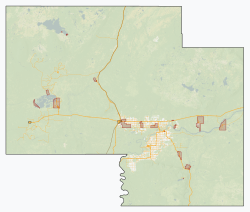Mackenzie County | |
|---|---|
 Welcome sign | |
 Location within Alberta | |
| Country | Canada |
| Province | Alberta |
| Region | Northern Alberta |
| Planning region | Lower Peace |
| Incorporated [1] - Municipal district | January 1, 1995 |
| - Specialized municipality | June 23, 1999 |
| Name change [1] | March 8, 2007 |
| Government | |
| • Reeve | Josh Knelsen [3] |
| • Governing body | Mackenzie County Council
|
| • CAO | Bryon Peters |
| • Administrative office | Fort Vermilion |
| Area (2021) [4] | |
| • Land | 79,629.26 km2 (30,745.03 sq mi) |
| Population (2021) [4] | |
• Total | 12,804 |
| • Density | 0.2/km2 (0.5/sq mi) |
| • Municipal census (2018) | 12,514 |
| Time zone | UTC−7 (MST) |
| • Summer (DST) | UTC−6 (MDT) |
| Website | mackenziecounty.com |
Mackenzie County is a specialized municipality in northern Alberta, Canada. It is located in Census Division 17, along the Mackenzie Highway. The municipal office is located in the hamlet of Fort Vermilion.


